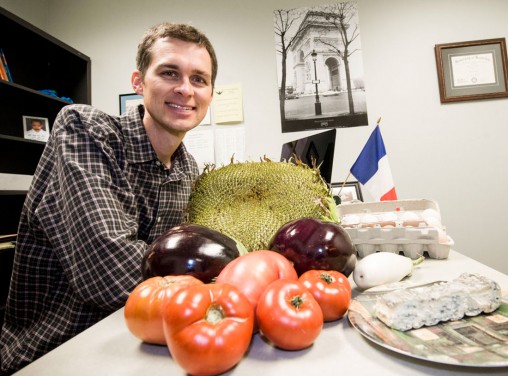
Wright State French instructor Benjamin Hirt combines cheese making and artisanal foods with French language lessons to help students better appreciate the history and culture of France.
Resting on the desk in his Millett Hall office is a creamy strip of handmade blue cheese – a silky, oozing, mouth-watering labor of love that new Wright State University French instructor Benjamin Hirt coaxed from the 12 goats on his farm.
Making the cheese took three weeks of hands-on, day-to-day work – heating, inoculating, curd-cutting, draining, pressing and brining. Then there is the aging process of up to three months that allows the cheese to “melt from the inside.”
Cheese-making is part of Hirt’s plan in the College of Liberal Arts to combine the teaching of French with the making of artisanal foods that will enable students to better appreciate the history and culture of France while expanding the growing popularity of farmers markets and healthy eating.
“Part of the reason I was brought on board was to come up with a service-learning course that would bring the agricultural, historical, cultural aspect of food in France home to the students so they can share it with their families, friends and communities,” he said.
Hirt’s love of French and food came together when he was growing up on the family farm in Sandusky County, Ohio. His mother, a Londoner, had met his father when he was stationed in Ireland with the U.S. Navy.
His mother’s tales about England and Wales stirred Hirt’s interest in Europe, and he was attracted to France because it seemed different and exciting. He loved the adventurous notion of eating rabbit, moldy (blue) cheese, snails (escargot) and pie without a top crust (quiche).

Attracted to France because it seemed different and exciting, Benjamin Hirt loves the notion of eating rabbit, blue cheese, escargot and quiche.
Hirt studied in France and Quebec as an undergraduate. After obtaining his master’s degree in French language and literature from the University of Kentucky, he taught French at the University of Cincinnati and Georgetown College in Kentucky and then spent four years working on his Ph.D. in French at The Ohio State University.
Hirt then taught French at Dublin-Scioto High School in the Columbus area, where he took students on study-abroad trips to Europe and wowed the staff during annual soup cook-offs with dishes such as roasted butternut squash soup, pheasant nugget stew and rabbit bourguignon.
Last spring, he brought his students to Wright State’s French immersion program, discovered a job opening and joined the faculty in the summer.
Hirt lives on a 6.5-acre farm in South Vienna, Ohio, where he raises goats, sheep, chickens, turkeys, geese, ducks and rabbits. He can grow anything in the garden and has a rototiller built by Ferrari, the Italian luxury sports car manufacturer.
Before coming to campus in the mornings, Hirt milks his goats, feeds his rabbits and releases his chickens into the pasture. After teaching classes, he returns home to collect eggs and milk the goats again.
One of the biggest influences on Hirt in his French studies and his time living in France was the pervasiveness of farm markets and the central role they play in everyday life. And he learned that the cheeses had their own identities.
“Every one of the cheeses has a story,” he said. “It says a lot about the community; it says a lot about the people; it says a lot about the history of the country. And I was always fascinated by that. So what I would like to do is bring my experience with that to the classroom.”
Hirt has made fresh goat cheese, blue cheese, brie, semi-soft cheeses, mozzarella and a type of queso fresco. For the Spanish department, he plans to make cajeta, which is similar to dulce de leche but made with goat’s milk, cinnamon and sugar. And he has provided duck eggs to the Chinese department so they can make salted eggs, considered a delicacy in China.
Hirt plans to bring goat’s milk from his farm to French Club meetings, where students will make cheese. By the spring of 2016, he hopes to have a cheese-making course that will also teach about heritage rabbits and artisan foods.
The students will then be encouraged to take their skills to their home communities to improve the quality and healthiness of local foods.
There were 8,144 farmers markets listed in the U.S. Department of Agriculture’s National Farmers Market Directory in August, a 3.6 percent increase from 2012. Hirt wants his students to add to the popularity of farmers markets and of independent, local restaurants that offer unique international fare.
“Ironically, it’s a very international perspective on a very local food system,” he said. “What can you learn from France and your French experience to have good food at home?”
Hirt said French majors have a variety of career opportunities. Many Ohio companies, for example, have French connections.
“We have a whole list of them,” he said. “Maybe they have businesspeople that work with a comparable company in France. Maybe they get some of their supplies from France. There are marketing jobs, there are farming jobs, there are political jobs.”
Hirt has become so passionate about French and about food that he has made careers out of both. And then there is France itself.
“Every time I go back, I’m just nourished by this alternative experience to life,” he said.

 Thousands celebrate the end of Spring Semester with food, fun and friendship
Thousands celebrate the end of Spring Semester with food, fun and friendship  Nearly 1,500 students to graduate at Wright State’s spring commencement ceremonies
Nearly 1,500 students to graduate at Wright State’s spring commencement ceremonies  Difficult conversations
Difficult conversations  Celebrated Wright State alum serving his community as surgeon
Celebrated Wright State alum serving his community as surgeon  Wright State University Foundation awards Students First Fund grants
Wright State University Foundation awards Students First Fund grants 